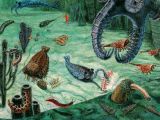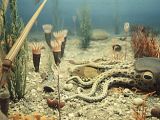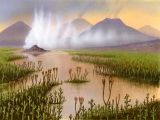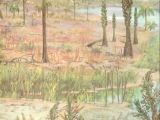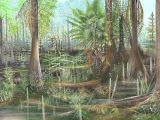The geological strata of the world are assigned to four ages: Primary, Secondary, Tertiary and Quaternary. The Earth is believed to be 4.5 billion years old, but the oldest rocks with visible fossils are just 590 million years old, from the beginning of the Cambrian. Cambrian fossils are made of a large array of life forms, like worms and mollusks, obviously evolved from more primitive forms.
A. Precambrian is the oldest eon, stretching from the Earth's emergence (4.5 billion years ago) until Cambrian (542 million of years ago). This is the epoch when life appeared, and the oldest traces of organic carbon seem to be 3.8 billion years old.
During the Proterozoic eon (1 billion years ago-542 million years ago) the oxygen started to accumulate in the atmosphere at the levels we know today. When the first fossils of complex animals appeared, the Cambrian started.
Organisms from Precambrian are less likely to have fossilized because they lacked a hard shell or skeleton; soft tissue totally decomposes after death, before the sediments manage to petrify them, turning them into fossils.
Still, in 1950, a 2 billion years old rock on the shore of Lake Superior, called flint silica, was found to contain remains of bacteria and monocellular algae. White rings on the rock proved to be eroded remains of their colonies - spherical rocky formations called stromatolites. Fossil bacteria and algae were embedded in the silica, like fossil insects in amber. This discovery made scientists re-examine old rocks. Still, the oldest bacterial life forms were encountered in Western Australia: 3.5 billion years old.
All eras that followed the Precambrian, till today, form the Phanerozoic, when complex life exploded on Earth. The Paleozoic Era (The Primary Era) ("ancient life") lasted from 541 to 251 million years ago, and it comprises 6 periods.
1. Cambrian (542-488 million years ago) takes its name from some old mountains found in Wales, which formed during this period. Most phyla of current animals appeared in this period, but the fauna of the Cambrian period was heavy shelled and also very static, dominated by trilobites, sponges, jellyfish, worms, shelled mollusks and echinoderms.
2. Ordovician (490-440 million years ago) was named after the Welsh tribe of Ordovices. The climate was warm and there was a huge southern continent, Gondwana. Many land surfaces were flooded. The first coral reefs appeared in this period. The fauna was dominated by herd shelled species (shells were mainly calcareous).
The fauna was dominated by corals, trilobites, brachiopods, sponges, echinoderms (sea lilies), shelled cephalopods, snails and bivalves. A giant shelled nautiloid cephalopod had a shell 4.75 m (15.8 ft) long! The first jawless vertebrates, called ostracoderms ("shell-skinned"), had appeared. They swam with the mouth opened, filtering small organisms in the water. A mass extinction occurred at the end of this age, when 60 % of the species disappeared.
3. Silurian (440-416 million years ago) - named after the Silures, an ancient Welsh tribe. The climate was warm. The seas were inhabited by echinoderms, brachiopods, sponges, bivalves, corals, bryozoa and snails. The fist jawed fish appeared in the lakes and rivers, the shark like Acanthodii, and seas were dominated by giant sea scorpions, up to 2.75 m (9 ft) long, now extinct. Leeches appeared in this period as well, but also did the first terrestrial animals ever, primitive spiders and millipedes. The first vascular plants started the conquest of the ground. Fungi grew as big as trees.
4. Devonian (416-359 million years ago) takes its name from Devon, England. This is when fish developed legs and evolved to land tetrapods around 365 Ma; the first insects also appeared and real spiders colonized terrestrial habitats. Many land masses were exposed during the Devonian.
The first seed-bearing plants formed huge forests. Mosses and fungi abounded. Primitive sharks started to dominate the ocean. The first ammonites, shelled mollusks that later evolved in squids and octopuses, appeared in this period.
The land was made by Gondwana to the south, the continent of Siberia to the north, and the Euramerica in the middle. A mass extinction occurred at the end of this era.
5. Carboniferous (359-300 Ma) means "carrying carbon" as huge deposits of high quality carbon formed in this period, revealing a wet, hot climate that favored the expansion of the forests. The vegetation was dominated by huge ferns (Sigillaria, Lepidodendron), horsetails and primitive gymnosperms (Cordaites), soft woods of rapid growth. Oxygen in the air was at a higher level than it is now, 36 %, and there were huge insects, such as 3 ft (1m) wingspan dragonflies. Most primitive insect groups still living emerged in that period. Snails went to the ground, too. The amphibians' diversity boomed and the first reptiles appeared.
6. Permian (300 to 250 Ma) takes its name from Perm, a Russian region close to the Ural mountains. The Earth experienced an Ice Age. Seas receded, exposing large land surfaces. Ural and Appalachian Mountains formed now. Clime turned drier and with more extreme seasons. Ferns were highly diversified, and gymnosperm trees, like ginkgos and cycads appeared in this period. Beetles and flies appeared. The land was dominated by mammal-like reptiles and pelycosaurs, sailed reptiles like Edaphosaurus (an herbivorous) or Dimetrodon (a carnivorous). A huge mass extinction occurred at the end of the Permian, when up to 95 % of the species went extinct.
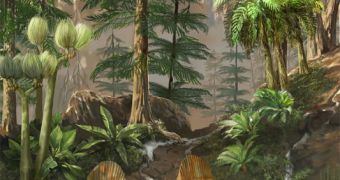
 14 DAY TRIAL //
14 DAY TRIAL // 
